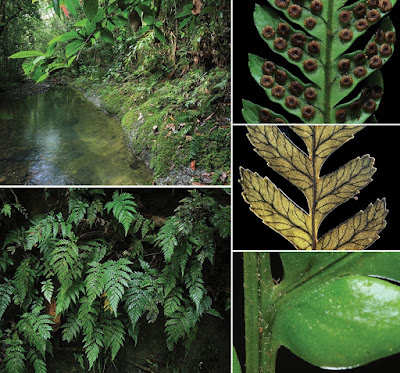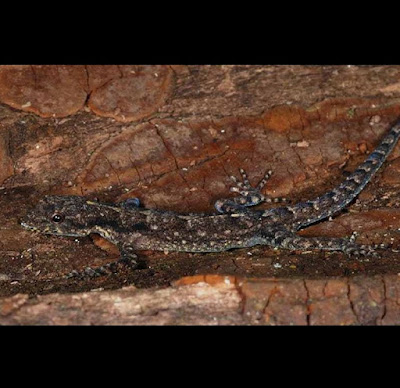[Most Recent Entries] [Calendar View]
Monday, April 17th, 2017
| Time | Event | ||||||
| 4:20a | [Botany • 2017] Phylogenetic Analyses Place the Monotypic Dryopolystichum within Lomariopsidaceae
Abstract The monotypic fern genus Dryopolystichum Copel. combines a unique assortment of characters that obscures its relationship to other ferns. Its thin-walled sporangium with a vertical and interrupted annulus, round sorus with peltate indusium, and petiole with several vascular bundles place it in suborder Polypodiineae, but more precise placement has eluded previous authors. Here we investigate its phylogenetic position using three plastid DNA markers, rbcL, rps4-trnS, and trnL-F, and a broad sampling of Polypodiineae. We also provide new data on Dryopolystichum including spore number counts, reproductive mode, spore SEM images, and chromosome counts. Our maximum-likelihood and Bayesian-inference phylogenetic analyses unambiguously place Dryopolystichum within Lomariopsidaceae, a position not previously suggested. Dryopolystichum was resolved as sister to a clade comprising Dracoglossum and Lomariopsis, with Cyclopeltis as sister to these, but clade support is not robust. All examined sporangia of Dryopolystichum produced 32 spores, and the chromosome number of sporophyte somatic cells is ca. 164. Flow cytometric results indicated that the genome size in the spore nuclei is approximately half the size of those from sporophyte leaf tissues, suggesting that Dryopolystichum reproduces sexually. Our findings render Lomariopsidaceae as one of the most morphologically heterogeneous fern families. A recircumscription is provided for both Lomariopsidaceae and Dryopolystichum, and selected characters are briefly discussed considering the newly generated data. Keywords: Fern, morphology, Papua New Guinea, phylogeny, recircumscription, taxonomy, the Solomon Islands
Conclusion: We have shown, based on molecular phylogenetic evidence, the placement of Dryopolystichum within Lomariopsidaceae. A revised description was provided for both Lomariopsidaceae and Dryopolystichum resulting from a review of literature and our own observations. Future studies using an expanded dataset are necessary to resolve intergeneric relationships in Lomariopsidaceae. Cheng-Wei Chen, Michael Sundue, Li-Yaung Kuo, Wei-Chih Teng and Yao-Moan Huang. 2017. Phylogenetic Analyses Place the Monotypic Dryopolystichum within Lomariopsidaceae. PhytoKeys. 78; 83-107. DOI: 10.3897/phytokeys.78.12040 | ||||||
| 1:33p | [Herpetology • 2017] Cnemaspis kandambyi • A New Species of Cnemaspis (Squamata: Gekkonidae) from Knuckles Range of Sri Lanka
Abstract A new species of Cnemaspis Strauch is described from Knuckles Range of Sri Lanka. This new species had been previously confused with Cnemaspis podihuna Deraniyagala. Cnemaspis kandambyi sp. nov. closely resembles C. podihuna and C. molligodai Wickramasinghe & Munindradasa. Cnemaspis kandambyi sp. nov. differs from C. podihuna by having 7–8 (versus 3–6) unpored scales in each side of the precloacal-femoral pores row, lacking (versus having) an internasal scale, body (axilla to groin) relatively long 47.7–48.3 (versus 38.1–38.7)% of SVL and dorsum dark brown (versus bright yellow). Cnemaspis kandambyi sp. nov. also distinguished from C. molligodai by having 4 (versus 5) precloacal pores, 5–6 (versus 7–9) femoral pores on each side, precloacal pores not in an inverted V-shaped arrangement (versus in inverted V-shaped arrangement), lacking (versus having) a distinct black marking on nape and a black lateral stripe begins behind eye extends laterally beyond the origin of forearm (versus not extending beyond the origin of forearm). Additionally, Cnemaspis kandambyi sp. nov. and C. molligodai show discrete distribution: former restricted to Knuckles Range and the latter confined to Lowland wet zone of Sri Lanka. We confirm that, no type material of Cnemaspis podihuna survive in the current collection of the National Museum of Sri Lanka. Keywords: Reptilia, Cnemaspis molligodai, holotype, Meemure, National Museum
Etymology. The species name is a patronym in the Latin genitive singular, in honour of Dharma Sri Kandamby (Former Curator of the vertebrate section of the National Museum of Sri Lanka [1982-2012]), for his contributions to the herpetology of Sri Lanka and for his guidance to both authors. Distribution and natural history. The new species was observed in large trees with epiphytes (Dendrobium sp.) in the Meemure area (~ 450 m msl) in the Knuckles Range (Fig. 3). Cnemaspis kandambyi sp. nov. is an arboreal and diurnal gecko.  Sudesh Batuwita and Sampath Udugampala. 2017. Description of A New Species of Cnemaspis (Squamata: Gekkonidae) from Knuckles Range of Sri Lanka. Zootaxa. 4254(1); 82–90. DOI: 10.11646/zootaxa.4254.1.4 |
| << Previous Day |
2017/04/17 [Calendar] |
Next Day >> |









